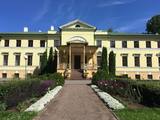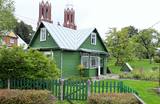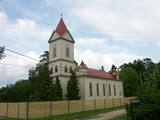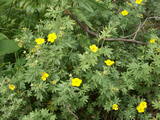| Nr | Name | Beschreibung |
|---|---|---|
|
Auf dem Bauernhof Epi auf der Insel Saaremaa werden Obst- und Beeren-Ketchups produziert, verschiedene Marmeladen hergestellt, Gewürzkräuter und Tees angebaut. Die Produkte werden nur aus lokalen Rohstoffen der Inseln Saaremaa und Muhu hergestellt. Die Produkte kann man direkt im Bauernhof kaufen. |
||
|
Dieser Park ist ein Gebiet, das vom Menschen kaum verändert wurde – Sandsteinklippen, verschiedene Höhlen, Biotope, Arten und Landschaften sind der attraktive Aspekt dieses Gebietes. Der Salaca-Fluss ist einer der wichtigsten Flüsse in der Ostseeregion als Laichgebiet für den Lachs, und es ist der zweitwichtigste Fluss für Wassertourismus in der lettischen Region von Vidzeme. Hier gibt es geologische Denkmäler, die für Besucher besonders attraktiv sind – Die Roten Klippen, der Skaņais-Berg, die Neļķu-Klippe, die Velna-(Teufels) Höhle usw. Hier sind auch solche Kulturdenkmäler wie der Livische Burgberg, der Vecsalaca - Gutshof, das Livische Museum, das Vantenberģi - Anwesen, die einzigartigen Neunaugen - Stauwehre usw. Im Park befindet sich auch eins der beliebtesten touristischen Ziele in Nordvidzeme – der Skaņākalna-Park, der ein dichtes Netz von Wanderpfaden hat. Der Salaca ist auch beliebt bei Fischern. Dies ist Teil des Nordvidzemer Biosphärenreservats.
|
||
|
The Naukšēni People’s Museum, where we tell intelligent people about those who were born at the NAUKŠĒNI DISCO, arrived here and stayed here. We’ll look at how they talk, sing, think and love. |
||
|
Das Museum wurde etwa 1990 begründet. Der Obstgarten, dessen Geschichte im Zusammenhang mit der Schriftstellerin B. Buivydaite steht, wurde 1935 gepflanzt. |
||
|
Das Gotteshaus befindet sich in der Sēravotu Straße 10. Das im Historismus gebaute Gebäude ist im Jahr 1899 aus Holz gebaut worden und es ist das neueste von allen drei Gotteshäusern von Ķemeri. Die Kirche kann man von innen an den Tagen besichtigen, wenn hier Gottesdienste abgehalten werden, zu anderen Zeiten – nur von außen. |
||
|
Das Gotteshaus wurde von 1742 – 1758 für die deutsche Gemeinde der Stadt nach einem Projekt von J.K. Dorn erbaut, der 55m hohe Turm wurde 1866 fertiggestellt. Die Fassade und das Interieur der Kirche sind im Spätbarock mit klassizistischen Zügen gehalten , im Interieur gibt es auch prunkvolle Elemente im Rokoko Stil. Das Gotteshaus ist bekannt für seine von 1773 – 1780 vom Halle’schen Orgelbauer Heinrich Andreas Contius erbaute Orgel . Nach dem Umbau von 1885 hat das Instrument heute über 7000 Pfeifen, 131 Register und 4 Manuale. Es gilt als die größte mechanische Orgel der Welt, es lohnt sich, sie in einem Konzert anzuhören! Besucher können Kirche und Orgel besichtigen und Kirchturm besteigen |
||
|
Der Sumpf, in den Schwefelwasser fließt, befindet sich auf der linken Seite des Abava – Flusstals. Das ist der einzige Ort in Lettland, wo das geschützte Fingerkraut in der Wildnis gefunden wird. Dieser Busch bedeckt etwa 1/5 des geschützten Territoriums. Hier sind Wälder, verschiedene Wiesenarten und Schwefelflüsse, darunter auch jener, der Teufelsauge genannt wird.
|
||
|
This is on the north-western shore of Lake Lielezers of Limbaži, at the start of the Lielezers nature trail. The tower opens up a view of the lake and its lovely shores. It is worth walking the trail, which is several kilometres long, because it is an interesting one. This is part of the ZBR. |
||
|
Saimniecībā tiek piedāvāti dažādi biškopības produkti: medus, bišu maize, propoliss, vaska sveces. Iespēja sarunāt izzinošu ekskursiju - ceļojums bišu pasaulē ar gulēšanu uz bitēm. Tiek piedāvāta arī loku šaušana un zāļu tējas. |
||
|
Auf dieser Tour wandern Sie durch die Kurische Nehrung von Nida nach Smiltynė. Der Nationalpark Kurische Nehrung liegt auf einer langen Sanddüne, die das Kurische Haff von der Ostseeküste trennt. An der westlichen Seite der Nehrung erstreckt sich ein Sandstrand von ~50 km, während das Ufer des Kurischen Haffs flach ist. Hier finden Sie kleinere Buchten, die mit Schilf bewachsen sind. Der baltische Küstenwanderweg beginnt im Zentrum von Nida in der Nähe des Hafens. In Nida schlängelt sich der Weg weiter am Ufer des Kurischen Haffs entlang und öffnet einen schönen Blick auf das weite Wasser. Von Nida bis zum Kap von Bulvikio windet sich der baltische Küstenwanderweg auf kleineren Waldwegen, durch mit Kiefern bewachsenen Dünen auf und ab. In der Siedlung von Preila verläuft der Pfad an der Promenade entlang. Im Abschnitt von Pervalka bis Juodkrantė führt der baltische Küstenwanderweg entlang eines schönen Sandstrands. In Juodkrantė können Sie auch den Pfad zum Raganų kalnas (Hexenberg) ausprobieren. Die Route wechselt zwischen der Ostseeküste, den Dünen und den Kurischen Haff, bis sie schließlich die Fähre erreicht, die Sie zum Festland nach Klaipėda bringt. |
||
|
The National Botanical Garden in Salaspils ranks as the largest botanical garden in Latvia and in the Baltics with a territory of 136 hectares. The National botanical garden collection consists of about 14 thousand different varieties. More than 5,000 plants are found in the arboretum, as well as various other exhibitions, such as orchards, rosaries, ornamental plants. Botanical Gardens can inspire you to uprade your own garden assortment with new plant varieties and offers the experience of learning about botanical knowledge in nature. In addition, it presents opportunity to expand your personal photo archive with an exclusive background photographs and close-ups. There is a playground for children, comfortable cycling paths, nordic walking paths, picnic possibilities. |
||
|
„Zaļmuiža” (Green Manor) is notable because of its legendary past. The protector of peasants and poet Peter
Miglinīks (1850 – 1883) worked there as a clerk in the beginning of the 19th century. In 1784, the building belonged
to Frederick von Korf. The manor was bought by officer of Russian army Nikolaj Paulin von Rosenschild. Once
the manor had a large farm (800 ha): several cattle-sheds, fruit and wine cellars, alcohol brewery. Now there in
only a manor house and a barn. Till 1960s, the manor house was the centre of kolkhoz „Liesma”, later the club.
Now there is a smithy of a craftsman Jānis Ļubka. Guests are welcome to watch and try the metal processing.
|
||
|
Die Region Aukštaitija ist eine der größten und ältesten Regionen Litauens. Seit dem 15.Jahrhundert wird sie «das echte Litauen» genannt. Auf dieser Reise werden Sie verschiedene regionale Köstlichkeiten genießen, die heutzutage in Aukštaitija angeboten werden. Im Bezirk Anykščiai werden Sie einen Heilkräuterhof besuchen. Dort gibt es Eichelkaffee und Kräutertee zu genießen. Ebenso ist die Einkehr im Fischerdorf Ginučiai vorgesehen, woher das Rezept für eine besondere Fischsuppe aus dem 17. Jahrhundert stammt. Im Bezirk Ignalina werden Sie eine Wassermühle und das Bienenkundemuseum besichtigen. Im Restaurant, das zum Netzwerk des Kulinarischen Erbes gehört, kann man den Gaumen mit den Spezialitäten der traditionellen Küche verwöhnen. Auch kann man selbst das Backen der traditionellen litauischen Süßspeise - Šakotis - ausprobieren. Nach dem Spaziergang entlang des Ufers des malerischen Zarasai-Sees begeben Sie sich zu einer Mühle. Dort werden Sie lernen, wie man Brot und Pfannkuchen aus Roggenmehl bäckt. Zum krönenden Abschluss der Reise ist der Besuch einer Brauerei geplant, die unfiltriertes lebendiges Bier braut. Ausgestellt wird dort auch eine Sammlung alter Brauerwerkzeuge. |
||
|
Kīdevas muiža rakstos ir minēta 1614. g., taču pašreiz redzamā divstāvu kungu māja, ir celta 19. gs. beigās. Ēkas sienas ir klātas ar koka šķindeļiem, kas viens otru pārklāj kā zivs zvīņas. Šāds kungu mājas sienu pārklājums Igaunijas mērogā ir unikāls. Laikā no 1919. – 1951. g. tajā atradās skola. Blakus muižai atrodas neliels parks. Diemžēl turpat pusgadsimtu ilgās pamestības rezultātā ēkas atrodas ļoti kritiskā stāvoklī. Tas ir arī pietiekams apmeklējuma iemesls. |
||
|
One of the loveliest apple orchards in Latvia (~10 ha, 30 types of apples) is on the sides of impressive hillocks. During clear weather, you can see the Bay of Rīga from atop the hillocks. The farm is particularly beautiful when apple trees are in bloom. Apples are available for tastings and purchase. |
||
|
Oranžērija Bekuciems ir ģimeniska svinību vieta 40 min braucienu attālumā no Rīgas, Tomes pagasta Bekuciemā. Šeit ir iespējams svinēt savus dzīves skaistākos notikumus - kāzas, krustabas, dzimšanas dienas, bērniņa raudzības, fotosesijas, atpūsties pie dabas, gatavot ēst un pašiem saklāt skaistu svētku galdu, organizēt korporatīvos pasākumus, iepazīstināt ārzemju tūristu grupas ar latviešu tautas tradīcijām un dzīvesveidu. Oranžērija ir apsildāma un darbojas visu gadu. Tās platība ir 4x6m un tajā ērti var justies nelielas kompānijas līdz 15 personām. Tā ir pilnībā aprīkota ar visu nepieciešamo atpūtai - mēbelēm, traukiem, galda piederumiem, kafijas aparātu un tējkannu, bezvadu bluetooth skaļruni, ledusskapi, plediem, svečturiem, svecēm, vāzēm, bērnu barošanas krēsliņi utt. Ap oranžēriju ir plaša teritorija, kurā var atpūsties liels skaits cilvēku. Te irpļavas, dīķis, āras atpūtas vieta, pirts un pirts nojume, grils, kūpinātava, ugunskura vieta un ugunskura zupas vieta, pļavas altāris, bērnu spēļu laukums, pļavas futbols, āras labierīcības. Blakus ir sēņošanas un pastaigu vietas Bekuciema slavenajos mežos. No saimnieces vasaras sezonā var sarunāt zaļumus, garšaugus un zāļu tēju. |
||
|
Der höchste Punkt im Südteil von Daugavpils – in der Umgebung der 18. Novembra Straße, wo auf einem relativ kleinen Territorium, im Umkreise von ~ 0,3 km sich die Kirchen von vier Konfessionen befinden: das Bethaus für Altgläubige in Daugavpils (1908 – 1928), die St. Boris und Gleb russisch-orthodoxe Kathedrale (1905), die römisch-katholische Kirche der Heiligsten Gottesmutter (1905) und die evangelisch-lutherische Kirche Martin Luthers (1893). |
||
|
Die einzigste noch heute funktionierende Flussfähre solches Typs im Baltikum. |
||
|
Veisieji reģionālais parks (Veisiejų regioninis parkas) veidots (1992.g.) Sudavas augstienes (Sūduvos aukštuma) ainavu, bioloģiskās daudzveidības un kultūras pieminekļu aizsardzībai. Viena no parka bagātībām ir ezeri, kuru iegarenās formas liecina par ledāja darbības rezultātu. Pēdējā apledojuma laikā šeit atradusies ledāja mala. Ezerus (kopā – 37) ieskauj lielāki meža masīvi uz kontinentālām (iekšzemes) kāpām, kas piemēroti atpūtai dabā, dabas vērošanai, ogošanai un sēņošanai. Parkā ir iekārtotas peldvietas, kur patīkami gremdēties vasaras tveicē, izveidotas dabas takas, bet mazās upītes, kas savieno ezerus, ir piemērotas braucieniem ar kanoe laivām. Veisieji reģionālā parka teritorijā ir liela augu un dzīvnieku daudzveidība. Šeit tiek aizsargātas arī tādas retas sugas kā Eiropas kokuvarde Hyla arborea (parka simbols), purva bruņurupucis Emys orbicularis, dažādas orhideju sugas u.c. |
||
|
Aktīvā atpūta svaigā gaisā, dabā. Dabas taka, atpūtas vieta, grilla vietas, lapenes. Lāzera cīņas jeb Laser tag ir spēle svaigā gaisā, ģimenes vai draugu kompānijā. Iegūsiet pozitīvas emocijas un kārtīgu adrenalīna devu, spēlējot augsti tehnoloģisko spēli reālā laikā un vietā. Lāzera cīņas ir visiem labi zināmā peintbola analogs, bet atšķirīgs ar to, ka Laser taga spēlē spēlētājus-pretiniekus “neitralizē” ar drošiem un nekaitīgiem lāzera šāvieniem no lāzera-ieroča, bet pati spēlētāja “neitralizācija” notiek, kad speciāli devēji (sensori), kuri ir nostiprināti uz spēlētāja apsaites, reģistrē pretinieka lāzera-ieroča staru, kas nozīmē, ka nav ne krāsu bumbiņu, ne sāpīgi sitieni, ne zilumi. Šī koncepcija padara Laser tagu pieejamu ne tikai vīriešiem, bet arī sievietēm un bērniem. |
||






















